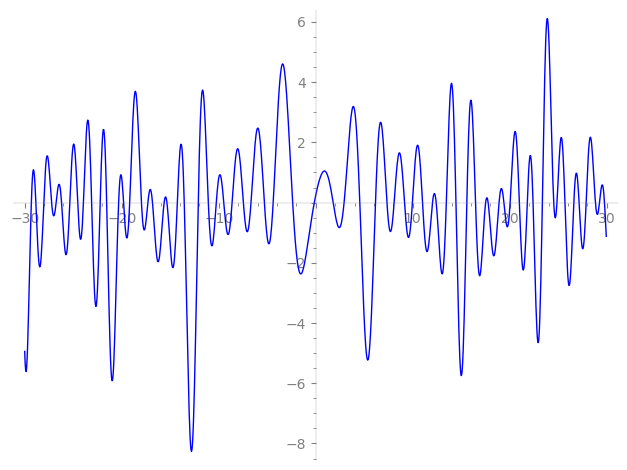| L(s) = 1 | + (−1.51 + 1.30i)2-s + 1.73i·3-s + (0.600 − 3.95i)4-s − 0.0471·5-s + (−2.25 − 2.62i)6-s − 2.88i·7-s + (4.24 + 6.78i)8-s − 2.99·9-s + (0.0714 − 0.0614i)10-s + 0.613i·11-s + (6.84 + 1.03i)12-s − 19.6·13-s + (3.76 + 4.38i)14-s − 0.0816i·15-s + (−15.2 − 4.74i)16-s − 16.6·17-s + ⋯ |
| L(s) = 1 | + (−0.758 + 0.651i)2-s + 0.577i·3-s + (0.150 − 0.988i)4-s − 0.00942·5-s + (−0.376 − 0.437i)6-s − 0.412i·7-s + (0.530 + 0.847i)8-s − 0.333·9-s + (0.00714 − 0.00614i)10-s + 0.0557i·11-s + (0.570 + 0.0866i)12-s − 1.50·13-s + (0.268 + 0.312i)14-s − 0.00544i·15-s + (−0.954 − 0.296i)16-s − 0.980·17-s + ⋯ |
\[\begin{aligned}\Lambda(s)=\mathstrut & 276 ^{s/2} \, \Gamma_{\C}(s) \, L(s)\cr =\mathstrut & (-0.150 + 0.988i)\, \overline{\Lambda}(3-s) \end{aligned}\]
\[\begin{aligned}\Lambda(s)=\mathstrut & 276 ^{s/2} \, \Gamma_{\C}(s+1) \, L(s)\cr =\mathstrut & (-0.150 + 0.988i)\, \overline{\Lambda}(1-s) \end{aligned}\]
Particular Values
| \(L(\frac{3}{2})\) |
\(\approx\) |
\(0.159113 - 0.185089i\) |
| \(L(\frac12)\) |
\(\approx\) |
\(0.159113 - 0.185089i\) |
| \(L(2)\) |
|
not available |
| \(L(1)\) |
|
not available |
\(L(s) = \displaystyle \prod_{p} F_p(p^{-s})^{-1} \)
| $p$ | $F_p(T)$ |
|---|
| bad | 2 | \( 1 + (1.51 - 1.30i)T \) |
| 3 | \( 1 - 1.73iT \) |
| 23 | \( 1 + 4.79iT \) |
| good | 5 | \( 1 + 0.0471T + 25T^{2} \) |
| 7 | \( 1 + 2.88iT - 49T^{2} \) |
| 11 | \( 1 - 0.613iT - 121T^{2} \) |
| 13 | \( 1 + 19.6T + 169T^{2} \) |
| 17 | \( 1 + 16.6T + 289T^{2} \) |
| 19 | \( 1 + 20.5iT - 361T^{2} \) |
| 29 | \( 1 - 22.9T + 841T^{2} \) |
| 31 | \( 1 + 5.53iT - 961T^{2} \) |
| 37 | \( 1 + 28.4T + 1.36e3T^{2} \) |
| 41 | \( 1 - 18.1T + 1.68e3T^{2} \) |
| 43 | \( 1 + 58.0iT - 1.84e3T^{2} \) |
| 47 | \( 1 + 51.1iT - 2.20e3T^{2} \) |
| 53 | \( 1 + 66.3T + 2.80e3T^{2} \) |
| 59 | \( 1 - 12.3iT - 3.48e3T^{2} \) |
| 61 | \( 1 + 74.6T + 3.72e3T^{2} \) |
| 67 | \( 1 + 63.3iT - 4.48e3T^{2} \) |
| 71 | \( 1 - 94.5iT - 5.04e3T^{2} \) |
| 73 | \( 1 + 40.7T + 5.32e3T^{2} \) |
| 79 | \( 1 - 122. iT - 6.24e3T^{2} \) |
| 83 | \( 1 - 27.6iT - 6.88e3T^{2} \) |
| 89 | \( 1 - 17.1T + 7.92e3T^{2} \) |
| 97 | \( 1 + 117.T + 9.40e3T^{2} \) |
| show more | |
| show less | |
\(L(s) = \displaystyle\prod_p \ \prod_{j=1}^{2} (1 - \alpha_{j,p}\, p^{-s})^{-1}\)
Imaginary part of the first few zeros on the critical line
−11.07141673607457879368470879809, −10.24952838227073763174704884601, −9.478661602658804930512911251852, −8.621556513697776694553863703849, −7.45828382402474303254300635555, −6.67226367541099213346788821713, −5.29391496719183921395607941727, −4.38507908270793084252834152127, −2.37553516679975338715527600775, −0.14719125063723135110022259247,
1.79740342194286661512946342816, 2.92426427853652939352447852493, 4.54368178021776095857456317708, 6.15740439686991990790298634008, 7.34112800886590855731563044446, 8.082604033680040989856099532445, 9.152450375869830007478672628195, 9.965034718426136846866091383059, 11.00900340287042888915251382331, 12.03926025763321776190513353332

